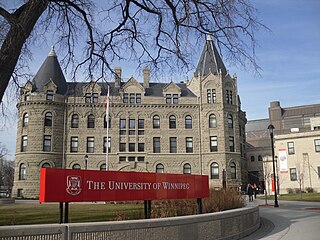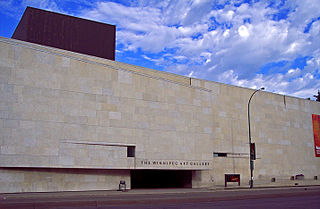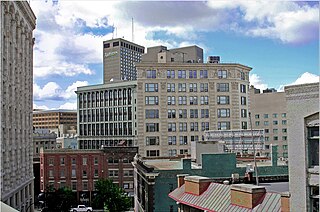Related Research Articles

Winnipeg is the capital and largest city of the province of Manitoba in Canada. It is centred on the confluence of the Red and Assiniboine rivers, near the longitudinal centre of North America. As of 2021, Winnipeg had a city population of 749,607 and a metropolitan population of 834,678, making it Canada's sixth-largest city and eighth-largest metropolitan area.

The University of Winnipeg is a public research university in Winnipeg, Manitoba, Canada. It offers undergraduate programs in art, business, economics, education, science and applied health as well as graduate programs. UWinnipeg's founding colleges were Manitoba College and Wesley College, which merged to form United College in 1938. The University of Winnipeg was established in 1967 when United College received its charter.

The Winnipeg Art Gallery (WAG) is an art museum in Winnipeg, Manitoba, Canada. Its permanent collection includes over 24,000 works from Canadian, Indigenous Canadian, and international artists. The museum also holds the world's largest collection of Inuit art. In addition to exhibits for its collection, the museum has organized and hosted a number of travelling arts exhibitions. Its building complex consists of a main building that includes 11,000 square metres (120,000 sq ft) of indoor space and the adjacent 3,700-square-metre (40,000 sq ft) Qaumajuq building.

The Manitoba Museum, previously the Manitoba Museum of Man and Nature, is a human and natural history museum in Winnipeg, Manitoba, as well as the province's largest, not-for-profit centre for heritage and science education.
Bruce Bunji Kuwabara, is a Canadian architect and a founding partner of the firm KPMB Architects. He is an invested Officer of the Order of Canada and recipient of the RAIC Gold Medal. He is Board Chair of the Canadian Centre for Architecture in Montreal.
Provincial Trunk Highway 75 is a major highway in the Canadian province of Manitoba. It is the main link between the city of Winnipeg and the United States border, where it connects with Interstate 29/U.S. Route 81.

Osborne Village is a neighbourhood of Winnipeg, Manitoba. The area is bordered by the Assiniboine River on the north and west, Harkness Station on the east, and the Osborne Underpass on the south.

Downtown Winnipeg is an area of Winnipeg located near the confluence of the Red and Assiniboine rivers. It is the oldest urban area in Winnipeg, and is home to the city's commercial core, city hall, the seat of Manitoba's provincial government, and a number of major attractions and institutions.

The Exchange District is a National Historic Site of Canada in the downtown area of Winnipeg, Manitoba, Canada. Just one block north of Portage and Main, the Exchange District comprises twenty city blocks and approximately 150 heritage buildings, and it is known for its intact early 20th century collection of warehouses, financial institutions, and early terracotta-clad skyscrapers.

Centennial Concert Hall is a 2,305-seat performing arts centre located at 555 Main Street in downtown Winnipeg, Manitoba, Canada, as part of the Manitoba Centennial Centre. The concert hall opened on March 25, 1968.
Étienne-Joseph Gaboury was a Canadian architect from Winnipeg, Manitoba. He was noted for designing key buildings in his hometown, such as the Royal Canadian Mint building, Esplanade Riel, Saint Boniface Cathedral, and the Precious Blood Church, and was regarded as the province's greatest architect.

Manitoba Hydro Place (MHP) is an office tower serving as the headquarters building of Manitoba Hydro, the electric power and natural gas utility in the province of Manitoba, Canada. Located at 360 Portage Avenue in downtown Winnipeg and connected to the Winnipeg Walkway system, Manitoba Hydro Place received LEED Platinum certification in May 2012, making it one of the most energy-efficient office towers in North America.

Central Park is a large urban park located in downtown Winnipeg, and forms the heart of the neighbourhood of the same name.
Patkau Architects is an architecture firm based in Vancouver, British Columbia, Canada. It is a full-service firm practicing in Canada and the United States. Its project scope includes, but is not limited to, gallery installations, art galleries, libraries, university buildings, urban planning and private residences. The firm has received numerous national and international architectural awards. Patkau Architects also represented Canada at the Venice Biennale in 2006.
Broadway is a street in the city of Winnipeg, Manitoba, Canada. It is one of the city's oldest and most historic routes and forms the Trans-Canada Highway route through the city's downtown.

Ralph Benjamin Pratt was a Canadian architect known for his work as a staff architect for the Canadian Pacific Railway and the Canadian Northern Railway, and for his work as a member of the firm Pratt and Ross with partner architect Donald Aynsley Ross.

Isadore "Issie" Coop (1926–2003) was a Canadian architect and a Fellow of the Royal Architectural Institute of Canada, with a reputation for highly functional, cost-effective architecture. A student of the famed American-German architect Ludwig Mies van der Rohe, Coop brought the Miesian style to Winnipeg, and changed the face of Winnipeg architecture, according to one writer.
Shelagh Jane Carter is a Canadian director, producer, screenwriter, actress and retired theatre and film professor at the University of Winnipeg, known initially for her short films Night Travellers, Canoe, and Rifting/Blue, and her feature films Passionflower, Before Anything You Say and Into Invisible Light. A Lifetime Member of the Actors Studio and a graduate of the Canadian Film Centre's Directors Lab in Toronto, she is also a recipient of the award, Women in the Director's Chair Career Advancement Module 2010, in collaboration with Women in Film Festival Vancouver, among many other honours. She is a member of the Winnipeg Film Group and chair of their Board.
Ernest John Smith was a Canadian architect.
David Paul Penner was a Canadian architect from Osborne Village in Winnipeg, Manitoba. He attended the University of Manitoba where he received his Bachelor of Environment Studies in 1979 and Masters of Architecture in 1985. Penner was the founding principal of David Penner Architect (DPA). He became a Fellow of the RAIC in 2012, and was involved in several organizations outside his firm including Storefront Manitoba and the Prairie Design Awards Program. His best-known architectural works include Fountain Springs Housing, Buhler Center, Windsor Park Library, and Mere Hotel. Penner died from a heart attack on January 7, 2020.
References
- 1 2 "DENNIS H. CARTER". Passages. Winnipeg Free Press. 30 June 2012. Retrieved 20 March 2019.
- ↑ "Dennis H. Carter, B.Arch., FRAIC, MOAA, MAA". MAA e-Bulletin (1). July 2012. Retrieved 15 December 2019.
- ↑ Thorsteinson, Jeffrey (2019). "A forgotten figure: Milton S. Osborne and the history of Modern architecture in Manitoba". In SSAC, [Society for the Study of Architecture in Canada] (ed.). Heritage, Diversity, and Belonging: 45th Annual Conference Halifax, NS May 28–31, 2019 (abstract). Dalhousie Architectural Press. p. 14. Retrieved 21 July 2019.
A number of significant modern architects graduated from the University of Manitoba's architecture program prior to 1946, among them Harry Seidler, John C. Parkin, Douglas C. Simpson, Harold Semmens, James Donahue, Ernest Smith, and Dennis Carter.
- ↑ Thorsteinson, Jeffrey (2015). "Two forgotten figures: Arthur A. Stoughton, Milton S. Osborne and the University of Manitoba School of Architecture". Network (2015). Retrieved 24 July 2019.
- ↑ "LESLIE RHOADES CARTER". Winnipeg Free Press. 16 March 2008. Retrieved 9 July 2019.